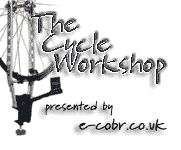Although many modern bikes have non-adjustable wheel bearings, many still require adjustment. If your bike has "cartridge" or non-adjustable bearings, you can skip this section. "Sealed hubs" only means that your bearings have seals to help keep dirt and water out, but does not identify whether your bearings are adjustable. Your local cycle retailer can help you figure out what you have.
If the bearings are too tight or too loose, you will soon damage the parts. By setting the bearing cones close together, the adjustment becomes tight. Screwing them farther apart causes looseness.
When a wheel is off the bike, set the adjustment to slightly loose, because clamping the wheel into the bike compresses the bearings slightly. Once installed, there should be just barely detectable looseness at the rim, or none at all.
Most hubs have thin locknuts that are jammed against the cones to keep the adjustment from drifting. To operate on this type of hub, loosen the locknut on one side using thin "cone wrenches", then retighten the locknut. If it is impossible to adjust the wheel so that the bearings are not too tight or not too loose at the same time, or if the bearings feel gritty when turned, a complete service is probably recommended to examine all parts for wear.
Also if the side of the wheel hub looks particularly dirty, and if the bearings are not sealed, then again a service is usually a good idea to clean out the old, dirty grease, and replace it with fresh grease.
To service the bearings, unscrew one locknut and bearing cone from the axle over a cloth. In most hubs, the bearings will fall out. Clean everything as much as you can, using a high quality degreaser. Examine everything for wear, especially the bearing cones, the cups (inner surfaces of the hub) and the ball bearings.
The ball bearings should be shiny, not dull. Although rare, you should check for cracking of the hub body itself, especially around the outsides of the cups.
Put fresh grease in the cups, stick the bearings into the grease, put the cones and locknuts back on the axle, and adjust properly.
If your hub has cages that hold the ball bearings, note which way they fall out and put them back the same way. Almost always, the balls face each other, and the backs of the cages face toward the outside.
|



